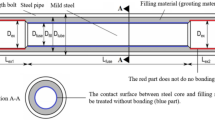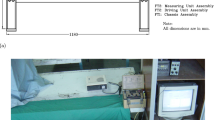Abstract
Low-cycle fatigue tests were conducted using smooth, cylindrical specimens under a strain-controlled, fully reversed condition for a high-strength spring steel heat treated to different strength levels. The variation of the cyclic deformation substructure was observed with a transmission electron microscope (TEM). The results indicate that the average plastic strain energy dissipated per cycle (ΔW ps ) is an important parameter upon which a consistent evaluation of the cyclic stress-strain, the strain-life, and the plastic strain energy-life relationships is made feasible. Furthermore, the total plastic strain energy dissipated prior to failure (W f ), determined on the basis of ΔW ps , is proven to be another important parameter, from the variation of which the extent of local damage accumulation can be evaluated. Confirmed by the results of TEM observations, a strain localization-induced damage mechanism is proposed and discussed.
Similar content being viewed by others
References
J.H. Ong: Int. J. Fatigue, 1993, vol. 15, pp. 213–19.
H.J. Roven and E. Nes: Acta Metall. Mater., 1991, vol. 39, pp. 1735–54.
K.S. Chan: Metall. Trans. A, 1993, vol. 24A, pp. 2473–86.
L.F. Coffin, Jr.: Trans. ASME, 1954, vol. 76, pp. 931–50.
S.S. Manson: Heat Transfer Symposium, University of Michigan Engineering Research Institute, Ann Arbor, MI, 1953, pp. 9–75.
L. Bairstow: Phil. Trans. R. Soc. London, Ser. A, 1910, vol. 210, pp. 35–55.
M.A. Miner: Trans. ASME, 1945, vol. 67, p. A159.
N. Enomoto: Proc. ASTM, 1955, vol. 55, p. 903.
R.F. Hanstock: Proc. Phys. Soc., 1947, vol. 59, pp. 275–87.
P.P. Benham and H. Ford: J. Mech. Eng. Sci., 1961, vol. 3, pp. 119–32.
JoDean Morrow: Internal Friction, Damping and Cyclic Plasticity, ASTM STP 378, ASTM, Philadelphia, PA, 1965, pp. 45–87.
G.R. Halford: J. Mater., 1966, vol. 1, pp. 3–18.
D. Lefebvre and F. Ellyin: Int. J. Fatigue, 1984, vol. 6, pp. 9–15.
S.R. Mediratta, V. Ramaswamy, and P. Rama Rao: Int. J. Fatigue, 1988, vol. 10, pp. 13–19.
K.M. Golos: Mater. Sci. Eng. A, 1989, vol. A111, pp. 63–69.
Y.W. Chung and W.J. Lee: Mater. Sci. Eng. A, 1994, vol. A186, pp. 121–28.
N. Eswara Prasad, A.G. Paradkar, G. Malakondaiah, and V.V. Kutumbarao: Scripta Metall. Mater., 1994, vol. 30, pp. 1497–1502.
S.G.S. Raman and K.A. Padmanabhan: Int. J. Fatigue, 1995, vol. 17, pp. 271–77.
W.H. Kim and C. Laird: Acta Metall., 1978, vol. 26, pp. 777–87.
K. Pohl, P. Mayr, and E. Marcherauch: Scripta Metall., 1980, vol. 14, pp. 1167–69.
H. Mughrabi, K. Herz, and X. Stark: Int. J. Fatigue, 1981, vol. 17, pp. 193–220.
C. Laird, P. Charsley, and H. Mughrabi: Mater. Sci. Eng., 1986, vol. 81, pp. 433–50.
P. Neuman: Mater. Sci. Eng., 1986, vol. 81, pp. 465–75.
Y. Liu: Mater. Sci. Eng. A, 1989, vol. A113, pp. 237–44.
J.A. Bannantine, J.J. Comer, and J.L. Handrock: Fundamentals of Metal Fatigue Analysis, Prentice-Hall, Engewood Cliffs, NJ, 1990.
S. Matsuoka, M. Yuyama, and S. Nishijima: Trans. Jpn. Soc. Mech. Eng., 1986, vol. A52, pp. 1831–38.
R.W. Landgraf: Fatigue and Microstructures, ASM, Metals Park, OH, 1978, pp. 439–66.
O.H. Basquin: Am. Soc. Test. Mater. Proc., 1910, vol. 10, pp. 625–30.
P.N. Thielen, M.E. Fine, and R.A. Fournelle: Acta Metall., 1976, vol. 24, pp. 1–10.
W.J. Plumbridge and N. Knee: Mater. Sci. Technol., 1985, vol. 1, pp. 577–82.
L.F. van Swam, R.M. Pelloux, and N.J. Grant: Metall. Trans., 1975, vol. 6, pp. 45–54.
A.C. Pickard and J.F. Knott: Low Cycle Fatigue, ASTM STP 942, ASTM, Philadelphia, PA, 1988, pp. 58–76.
S.G.S. Raman and K.A. Padmanabhan: Int. J. Fatigue, 1992, vol. 14, pp. 295–304.
Author information
Authors and Affiliations
Rights and permissions
About this article
Cite this article
Li, D.M., Nam, W.J. & Lee, C.S. A strain energy-based approach to the low-cycle fatigue damage mechanism in a high-strength spring steel. Metall Mater Trans A 29, 1431–1439 (1998). https://doi.org/10.1007/s11661-998-0358-9
Received:
Issue Date:
DOI: https://doi.org/10.1007/s11661-998-0358-9




